被动语态讲解
被动语态的讲解
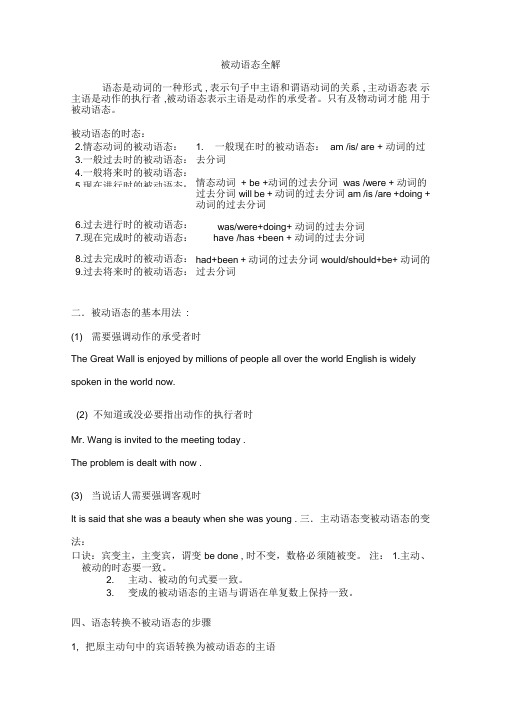
2.情态动词的被动语态:3.一般过去时的被动语态:4.一般将来时的被动语态:5.现在进行时的被动语态:6.过去进行时的被动语态:7.现在完成时的被动语态:8.过去完成时的被动语态:9.过去将来时的被动语态:被动语态全解语态是动词的一种形式, 表示句子中主语和谓语动词的关系, 主动语态表示主语是动作的执行者,被动语态表示主语是动作的承受者。
只有及物动词才能用于被动语态。
被动语态的时态:1. 一般现在时的被动语态:am /is/ are + 动词的过去分词情态动词+ be +动词的过去分词was /were + 动词的过去分词will be + 动词的过去分词am /is /are +doing +动词的过去分词was/were+doing+ 动词的过去分词have /has +been + 动词的过去分词had+been + 动词的过去分词would/should+be+ 动词的过去分词二.被动语态的基本用法:(1) 需要强调动作的承受者时The Great Wall is enjoyed by millions of people all over the world English is widely spoken in the world now.(2) 不知道或没必要指出动作的执行者时Mr. Wang is invited to the meeting today .The problem is dealt with now .(3) 当说话人需要强调客观时It is said that she was a beauty when she was young . 三.主动语态变被动语态的变法:口诀:宾变主,主变宾,谓变be done , 时不变,数格必须随被变。
注:1.主动、被动的时态要一致。
2. 主动、被动的句式要一致。
3. 变成的被动语态的主语与谓语在单复数上保持一致。
四、语态转换不被动语态的步骤1, 把原主动句中的宾语转换为被动语态的主语2, 把动词改为被动语态形式即"be+ 过去分词"。
被动语态知识点讲解(更全面,思路清晰)
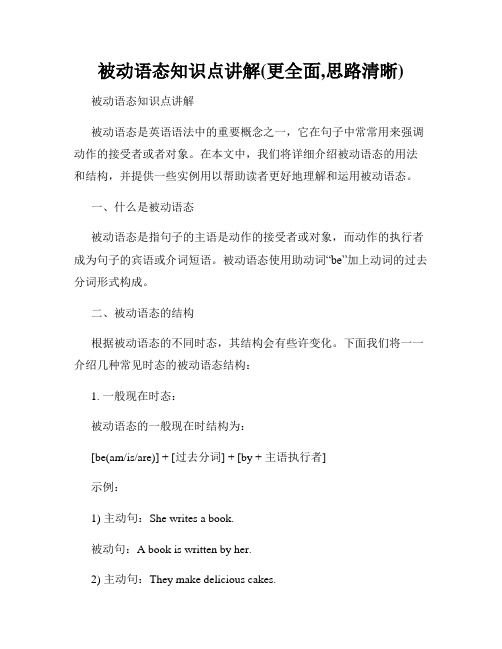
被动语态知识点讲解(更全面,思路清晰)被动语态知识点讲解被动语态是英语语法中的重要概念之一,它在句子中常常用来强调动作的接受者或者对象。
在本文中,我们将详细介绍被动语态的用法和结构,并提供一些实例用以帮助读者更好地理解和运用被动语态。
一、什么是被动语态被动语态是指句子的主语是动作的接受者或对象,而动作的执行者成为句子的宾语或介词短语。
被动语态使用助动词“be”加上动词的过去分词形式构成。
二、被动语态的结构根据被动语态的不同时态,其结构会有些许变化。
下面我们将一一介绍几种常见时态的被动语态结构:1. 一般现在时态:被动语态的一般现在时结构为:[be(am/is/are)] + [过去分词] + [by + 主语执行者]示例:1) 主动句:She writes a book.被动句:A book is written by her.2) 主动句:They make delicious cakes.被动句:Delicious cakes are made by them.2. 现在进行时态:被动语态的现在进行时结构为:[be(am/is/are)] + [being] + [过去分词] + [by + 主语执行者]示例:1) 主动句:He is washing the car.被动句:The car is being washed by him.2) 主动句:They are building a house.被动句:A house is being built by them.3. 一般过去时态:被动语态的一般过去时结构为:[be(was/were)] + [过去分词] + [by + 主语执行者]示例:1) 主动句:She bought a new car.被动句:A new car was bought by her.2) 主动句:They painted the wall.被动句:The wall was painted by them.4. 过去进行时态:被动语态的过去进行时结构为:[be(was/were)] + [being] + [过去分词] + [by + 主语执行者]示例:1) 主动句:He was cleaning the house.被动句:The house was being cleaned by him.2) 主动句:They were repairing the car.被动句:The car was being repaired by them.三、被动语态的用法被动语态的使用可以有多种情况,下面是几个常见的用法:1. 强调行为的接受者:被动语态可以强调动作的接受者或者对象,使其在句子中得到突出。
被动语态讲解

初中被动语态英语动词有主动语态和被动语态之分。
主动语态句子中的主语是动作的执行者,被动语态句子中的主语是动作的承受者。
被动语态由“be + v-ed”构成。
关于动词的语态变化请看下表:动词的语态变化一.主动语态变被动语态的变法:口诀:宾变主,主变宾,谓变be done ,时不变,数格必须随被变。
注:1.主动、被动的时态要一致。
2.主动、被动的句式要一致。
3.变成的被动语态的主语与谓语在单复数上保持一致。
二、被动语态用于以下几种情况1. 不知道或没有必要指出动作的执行者。
如:Many new buildings are built in our city.2. 强调动作的承受者。
如:The wounded man has been sent to a hospital.3. 动作执行者有比较长的修饰语。
如:The person was supported by those who wished to have a ch ance to make friends with him.4. 出于礼貌,不愿说出动作的执行者。
如:You are requested to attend the party三,被动语态的基本用法:1使用被动语态时应注意的几个问题。
1). 带双宾语的主动结构的句子,变为被动语态结构时,只能将其中的一个宾语变为主语,另一个宾语仍要保留。
如果保留的是间接宾语,要在间接宾语之前加上介词to或for.如:We are taught English by her.或English is taught to us by he r.2). 主动语态中的不带to的动词不定式作宾补变为被动语态时,要加上不定式符号to.如:The boss made him work over twelve hours a day.He was made to work over twelve hours a day.3). 短语动词用于被动语态应作为一个整体,不能丢掉其中的介词或副词。
英语被动语态讲解

一、被动语态的构成形式
2. 被动语态的特殊结构形式
1)带情态动词的被动结构。其形式为:情态动词+ be+过去分词。 The baby should be taken good care of by the baby-sitter.
2) 有些动词可以有两个宾语,在用于被动结构时, 可以把主动结构中的一个宾语变为主语, 另一宾 语仍然保留在谓语后面。通常变为主语的是间接宾 语。 His mother gave him a present for his birthday.
态和完成时态) 。 I don't like being laughed at in the public.
二、被动语态的各种句型
1.单宾语结构。
Our English teacher often uses a taperecorder in teaching English.我们英语老师经 常用录音机教英语。(主动语态)
The children must be taken good care of . 这些孩子必须得到好的照顾。
The big fire has been put out . 大火已被 扑灭。
三、 It is said that+从句及其他类似 句型
一些表示“据说”或“相信”的动词如believe, consider, expect, report, say, suppose, think等可 以用于句型“It+be+过去分词+that从句”或“主 语+be+过去分词+to do sth.”。有:
It is said that… 据说, It is reported that…据报道, It is believed that…大家相信, It is hoped that…大家希望, It is well known that…众所周知 It is thought that…大家认为, It is suggested that…据建议。
被动语态讲解

过去时被动语态
构成方式
be动词的过去式( was/were)+过去分词
用法
表示过去的动作,强调动 作承受者
例句
The window was broken by the boy.(窗户被那个 男孩打破了。)
将来时被动语态
构成方式
01
will be+过去分词
用法
02
表示将来的动作,强调动作承受者
例句
将主动句中的动词变 为被动形式(be + 过去分词)。
保留原句主语作为by短语出现情况
当需要强调动作的执行者时, 可以保留原句主语作为by短语 出现。
当被动句的主语是泛指或不明 确时,可以保留原句主语作为 by短语来明确动作的执行者。
当需要对比主动句和被动句时 ,可以保留原句主语作为by短 语来保持句子的一致性。
03
不要过度使用被动语态 ,以免导致句子显得生 硬、不自然。
04
在某些情况下,主动语 态和被动语态可交替使 用,以达到不同的表达 效果。
04 被动语态转换技 巧及实例分析
将主动句转换为被动句方法论述
找出主动句中的宾语 ,将其作为被动句的 主语。
将主动句的主语作为 被动句的by短语出现 ,或者省略by短语。
过去分词是动词的一种形式,用于 表示动作的完成或被动。在被动语 态中,过去分词与助动词be一起 构成谓语。
主语
被动语态中的主语通常是动作的承 受者,而不是执行者。主语可以是
名词、代词、数词等。
宾语(可选)
在某些情况下,被动语态中也可以 包含宾语,用于进一步说明动作的 对象或结果。但宾语不是被动语态
的必要成分。
被动语态讲解
目 录
被动语态讲解
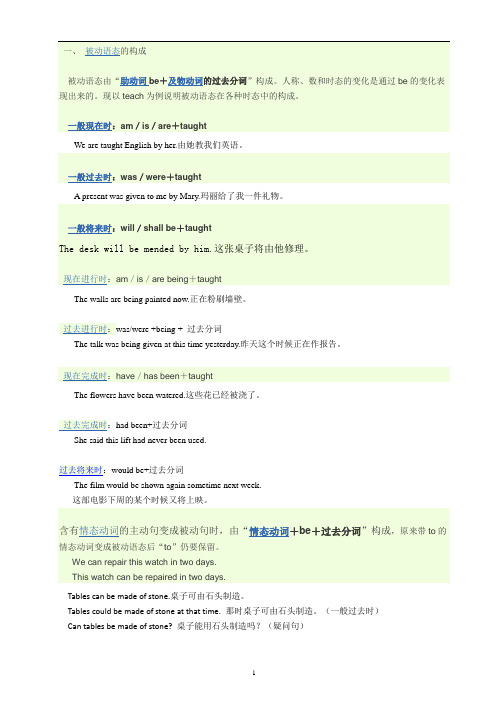
被动语态由“助动词be+及物动词的过去分词”构成。
人称、数和时态的变化是通过be的变化表现出来的。
现以teach为例说明被动语态在各种时态中的构成。
一般现在时:am/is/are+taughtWe are taught English by her.由她教我们英语。
一般过去时:was/were+taughtA present was given to me by Mary.玛丽给了我一件礼物。
一般将来时:will/shall be+taughtThe desk will be mended by him.这张桌子将由他修理。
现在进行时:am/is/are being+taughtThe walls are being painted now.正在粉刷墙壁。
过去进行时:was/were +being + 过去分词The talk was being given at this time yesterday.昨天这个时候正在作报告。
现在完成时:have/has been+taughtThe flowers have been watered.这些花已经被浇了。
过去完成时:had been+过去分词She said this lift had never been used.过去将来时:would be+过去分词The film would be shown again sometime next week.这部电影下周的某个时候又将上映。
含有情态动词的主动句变成被动句时,由“情态动词+be+过去分词”构成,原来带to的情态动词变成被动语态后“to”仍要保留。
We can repair this watch in two days.This watch can be repaired in two days.Tables can be made of stone.桌子可由石头制造。
Tables could be made of stone at that time. 那时桌子可由石头制造。
被动语态知识点讲解

被动语态知识点讲解一.基本结构1.一般现在时的被动语态结构:is/am/are+过去分词E.g.①The boy is looked after by his father. 这个小孩由他父亲照顾。
2.一般过去时的被动语态结构:was/were+过去分词E.g.①The cup was broken by Tom. 这个杯子是被汤姆打破的。
3.一般将来时的被动语态结构:will+be+过去分词E.g.①They will be allowed to go to school. 他们将会被允许去上学。
4.现在完成时的被动语态结构:has/have+been+过去分词E.g.①The battery hasn’t been charged for a couple of months. 电池好几个月没有充电了5.情态动词的被动语态结构:情态动词+be+过去分词E.g.①Today information can be received online. 现在,信息可以从网上接收到。
二.标志词1.一般现在时:usually,always,sometimes,often,every短语,never等。
2.一般过去时:ago, yesterday, the day before yesterday, last 短语, in +年, just now, at the age of , one day, once upona time, then, on that day等。
3.一般将来时:tomorrow,the day after tomorrow ,next短语in the future 等。
4.现在完成时:already,yet,just,before,since,for,ever,never,so far等。
5.情态动词:can, may, must, could, might, shall , should, will, would, need等。
被动语态详解
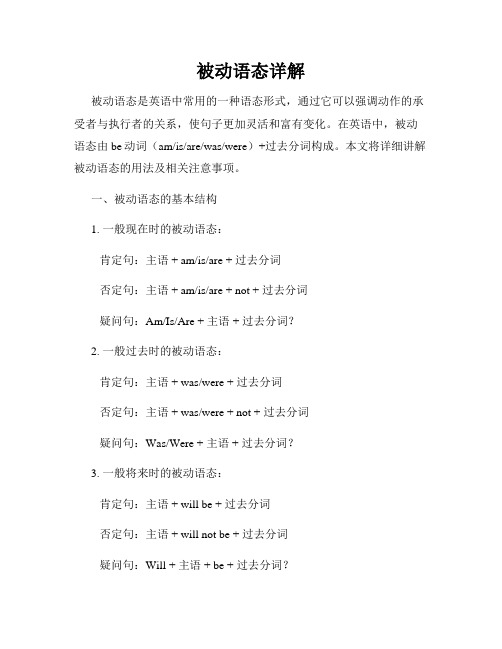
被动语态详解被动语态是英语中常用的一种语态形式,通过它可以强调动作的承受者与执行者的关系,使句子更加灵活和富有变化。
在英语中,被动语态由be动词(am/is/are/was/were)+过去分词构成。
本文将详细讲解被动语态的用法及相关注意事项。
一、被动语态的基本结构1. 一般现在时的被动语态:肯定句:主语 + am/is/are + 过去分词否定句:主语 + am/is/are + not + 过去分词疑问句:Am/Is/Are + 主语 + 过去分词?2. 一般过去时的被动语态:肯定句:主语 + was/were + 过去分词否定句:主语 + was/were + not + 过去分词疑问句:Was/Were + 主语 + 过去分词?3. 一般将来时的被动语态:肯定句:主语 + will be + 过去分词否定句:主语 + will not be + 过去分词疑问句:Will + 主语 + be + 过去分词?二、被动语态的用法1. 强调动作的承受者:主动语态:Tom wrote a letter.(汤姆写了一封信。
)被动语态:A letter was written by Tom.(一封信被汤姆写了。
)2. 当不知道或不关心动作的执行者时:主动语态:Someone broke the window.(有人打破了窗户。
)被动语态:The window was broken.(窗户被打破了。
)3. 当动作的执行者为明显的、普遍的或不需要具体指出时:主动语态:People speak English all over the world.(世界各地的人都说英语。
)被动语态:English is spoken all over the world.(英语在世界各地都被说着。
)4. 相应的介词有些动词后面需要与特定的介词连用,在被动语态中需要保留这些介词。
主动语态:They laughed at the man.(他们嘲笑那个人。
被动语态(讲解)

被动语态1:英语中语态有两种:主动语态和被动语态。
语态的作⽤:语态是动词的⼀种形式,⽤来说明主语和谓语之间的关系。
语态的选⽤:如果主语是动作的执⾏者,谓语⽤主动语态。
例如:We clean the room every day.如果主语是动作的承受者,或者说是动作的对象,谓语则是要⽤被动语态。
例如:The room is cleaned every day.2:被动语态的各种形式1) am/is/are +doneeg:I'm asked to take care of myself.eg:Football is played all over the world.2)has /have been doneeg:This book has been translated into many foreign languages.eg:The prices of many goods have been cut again .3)am/is /are being doneeg:A road is being built around the mountain.eg:Many new houses are being built in this city.4) was/were doneeg1:This house was built in 1958.eg2:His leg was broken in an accident.5) had been doneeg1:A new school had been set up by the end of last year.eg2:When the anthem had been played the conference began.6) was/were being doneeg1: meeting was being held when I was there.eg2:We were being trained this time last year.7) shall/will be doneeg1:More factories will be built in our city.eg2:He will be taken to hospital tomorrow.8) shall/will have been doneeg1:The project will have been completed before July.eg2:Your clothes shall have been made for you soon.9) should/would be doneeg1:He told me that his new cloths would be made by his mother.10) should/would have been doneeg1:He told me that his new clothes would have been made very soon.3:主动形式表⽰被动意义1)及物动词的不及物⽤法:主语通常是物,且有着某种内在的特点。
(完整)被动语态讲解
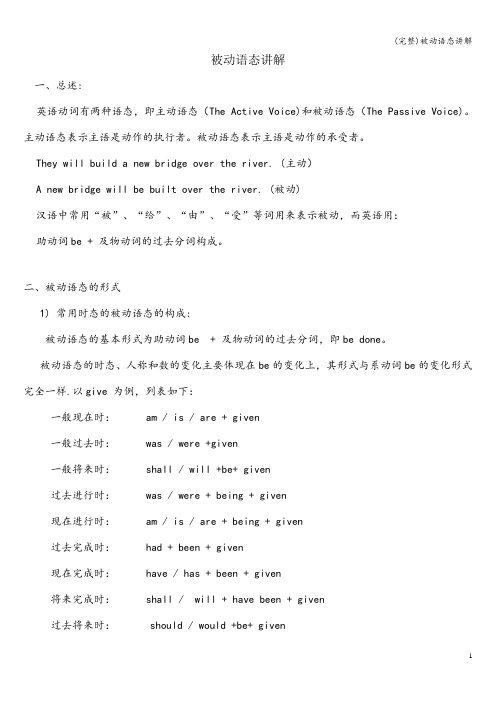
被动语态讲解一、总述:英语动词有两种语态,即主动语态(The Active Voice)和被动语态(The Passive Voice)。
主动语态表示主语是动作的执行者。
被动语态表示主语是动作的承受者。
They will build a new bridge over the river. (主动)A new bridge will be built over the river. (被动)汉语中常用“被”、“给”、“由”、“受”等词用来表示被动,而英语用:助动词be + 及物动词的过去分词构成。
二、被动语态的形式1) 常用时态的被动语态的构成:被动语态的基本形式为助动词be + 及物动词的过去分词,即be done。
被动语态的时态、人称和数的变化主要体现在be的变化上,其形式与系动词be的变化形式完全一样.以give 为例,列表如下:一般现在时:am / is / are + given一般过去时:was / were +given一般将来时:shall / will +be+ given过去进行时:was / were + being + given现在进行时:am / is / are + being + given过去完成时:had + been + given现在完成时:have / has + been + given将来完成时:shall / will + have been + given过去将来时: should / would +be+ given现在完成进行时:have/has been being done含情态动词的被动语态:情态动词+be done[注]被动语态没有将来进行时和过去将来进行时.2)被动语态的否定式:在第一个助动词后加not构成.Russian is not taught in our school. 我们学校不教俄语。
3)被动语态的疑问式:把第一个助动词提到主语之前,句尾加问号构成。
被动语态讲解
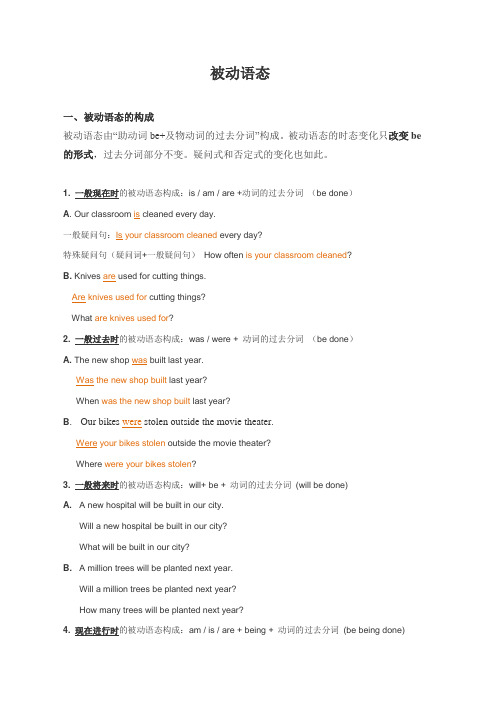
被动语态一、被动语态的构成被动语态由“助动词be+及物动词的过去分词”构成。
被动语态的时态变化只改变be 的形式,过去分词部分不变。
疑问式和否定式的变化也如此。
1.特殊疑问句(疑问词+一般疑问句)How often is your classroom cleaned?What are knives used for?2.When was the new shop built last year?B. Our bikes were stolen outside the movie theater.Where were your bikes stolen?3.A. A new hospital will be built in our city.Will a new hospital be built in our city?What will be built in our city?B. A million trees will be planted next year.Will a million trees be planted next year?How many trees will be planted next year?4.A. Uncle Wang is mending my bike now.→ My bike is being repaired by Uncle Wang now.Is your bike being repaired by Uncle Wang now?Who is your bike being repaired by now?By whom is your bike being repaired now?B. They are planting trees over there.→ Trees are being planted over there by them.Are trees being planted over there by them?5.A. People have translated this book into many languages.→This book has been translated into many languages.Has this book been translated into many languages?B. Many countries have sent up many man-made satellites into space.→Many man-made satellites have been sent up into space by many countries.Have many man-made satellites been sent up into space by many countries?C. Jane has helped this kid for ten years.→This kid has been helped by Jane for ten years.Has this kid been helped by Jane for ten years?How long has this kid been helped by Jane?6. 其时态及句型的变化仅由情态动词完成,“be+过去分词”部分不变A.We must water young trees often.→Young trees must be watered often.Must young trees be watered often?B.You should correct your mistakes right now.Your mistakes should be corrected right now.Should my mistakes be corrected right now?C.You can hand in your homework tomorrow.Your homework can be handed in tomorrow.Can my homework be handed in tomorrow?二、主动语态变为被动语态的注意事项(1)含有双宾语,即直接宾语和间接宾语的句子,每个宾语都可变为被动语态的主语,即其被动语态有两种形式。
被动语态的用法讲解

被动语态的用法讲解一、什么是被动语态被动语态是英语中一种常用的句式结构,它强调主语受到动作的影响或承受了某种行为。
在被动语态中,主动词的对象变成了句子的主语,而原来的主语则变成了介词by短语中使用。
被动语态特别适用于当我们不知道或者不关心谁执行了动作时。
二、构造被动语态被动语态由“be”(根据时态和人称变化)+过去分词构成。
下面是各种时态下的例子:1. 一般现在时:am/is/are + 过去分词主动:She eats an apple.被动:An apple is eaten by her.2. 一般过去时:was/were + 过去分词主动:They opened the door.被动:The door was opened by them.3. 一般将来时:will be + 过去分词主动:He will write a book.被动:A book will be written by him.4. 现在完成时:has/have been + 过去分词主动:We have finished the project.被动:The project has been finished by us.5. 现在进行时:am/is/are being + 过去分词主动:She is reading a book.被动:A book is being read by her.6. 过去进行时:was/were being + 过去分词主动:They were painting the house.被动:The house was being painted by them.三、被动语态的用法1. 强调行为受害者被动语态用于突出行为或事件的受害者,使其成为句子的重点。
例如:主动:The dog bit John.被动:John was bitten by the dog.在这个例子中,主语从"dog"变成了"John",强调了John受到了咬伤。
被动语态讲解及注意事项
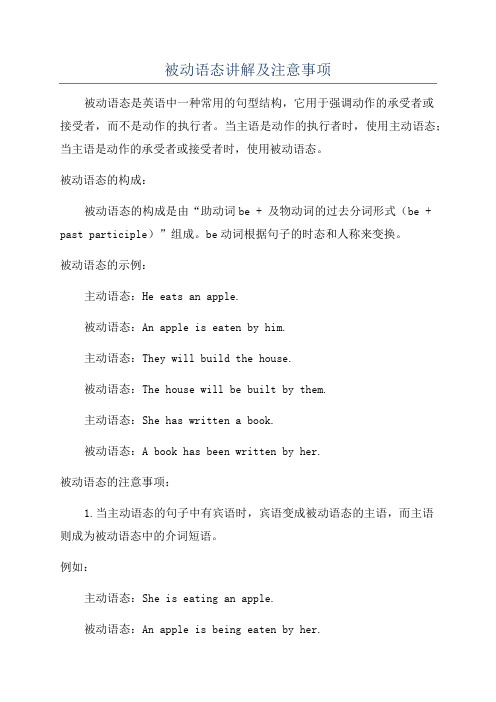
被动语态讲解及注意事项被动语态是英语中一种常用的句型结构,它用于强调动作的承受者或接受者,而不是动作的执行者。
当主语是动作的执行者时,使用主动语态;当主语是动作的承受者或接受者时,使用被动语态。
被动语态的构成:被动语态的构成是由“助动词be + 及物动词的过去分词形式(be + past participle)”组成。
be动词根据句子的时态和人称来变换。
被动语态的示例:主动语态:He eats an apple.被动语态:An apple is eaten by him.主动语态:They will build the house.被动语态:The house will be built by them.主动语态:She has written a book.被动语态:A book has been written by her.被动语态的注意事项:1.当主动语态的句子中有宾语时,宾语变成被动语态的主语,而主语则成为被动语态中的介词短语。
例如:主动语态:She is eating an apple.被动语态:An apple is being eaten by her.注意:主动语态中的宾语“an apple”变成了被动语态中的主语,“she”则成为了被动语态中的介词短语“by her”。
2. 当主动语态的句子中没有宾语时,用“by + 主语”来表示动作的执行者。
例如:主动语态:He sings well.被动语态:Well is sung by him.注意:原句中没有宾语,所以被动语态中使用“by + 主语”来表示动作的执行者。
3.若主动语态中的动词是不及物动词,则不能使用被动语态。
例如:主动语态:He sleeps.被动语态:错误,不能用被动语态。
4. 根据句子的时态,使用相应的be动词形式。
下面是be动词在不同时态和人称下的变化:一般现在时:am/is/are一般过去时:was/were一般将来时:will be现在进行时:am/is/are being过去进行时:was/were being现在完成时:has/have been过去完成时:had been5.注意主动语态中的时态、人称和数量与被动语态中的时态、人称和数量的一致性。
英语语法被动语态讲解

被动语态一、被动语态在各种时态中的结构一般现在时:be done(be随人称变化)一般过去时:was/were done一般将来时:will be done现在进行时:be being done(前面的be随人称变化,后面的being固定)过去进行时:was/were being done(being固定)现在完成时:have/has been done过去完成时:had been done过去将来时:would be done将来完成时:will have been done将来进行时:will be being done(being固定)将来完成进行时:will have been being done现在完成进行时:have been being done过去将来完成时:would have been done过去完成进行时:had been being done过去将来进行时:would be being done过去将来完成进行时:would have been being done二、被动语态的基本用法:被动语态表示一种主语和谓语之间的关系,当主语是动作的承受者时,就需要用到被动语态,汉语中所说的,“汽车被撞坏了”“钢笔被修好了” 等句子就是一种被动语态的句子,在汉语中常用“被”“由”等词来表示这种被动语态。
在英语中则用动词的被动语态形式来表示。
被动语态中还可用by 短语加在句后表示被动语态中动作的发出者。
也就是谓语动词动作的逻辑上的主语,被动语态常用在下列情况。
1、不知道谁是谓语动词动作的执行者时,或者没有必要说出谁是执行者时。
The glass was broken last night. 玻璃昨天被打破了。
His bike has been stolen. 他的自行车被偷了。
He was asked to go there once more. 他被要求再去那儿一次。
2、为了强调或突出动作的承受者时。
被动语态讲解
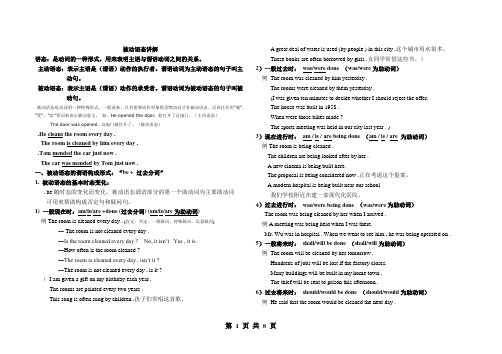
被动语态讲解语态:是动词的一种形式,用来表明主语与谓语动词之间的关系。
主动语态:表示主语是(谓语)动作的执行者。
谓语动词为主动语态的句子叫主动句。
被动语态:表示主语是(谓语)动作的承受者。
谓语动词为被动语态的句子叫被动句。
被动语态是动词的一种特殊形式,一般说来,只有需要动作对象的及物动词才有被动语态。
汉语往往用"被"、"受"、"给"等词来表示被动意义。
如:He opened the door. 他打开了这扇门。
(主动语态)The door was opened. 这扇门被打开了。
(被动语态).He cleans the room every day .The room is cleaned by him every day ..Tom mended the car just now .The car was mended by Tom just now .一、被动语态的谓语构成形式:“be + 过去分词”1. 被动语态的基本时态变化:. be随时态的变化而变化,被动语态谓语部分的第一个助动词为主要助动词可用来帮助构成否定句和疑问句。
1) 一般现在时:am/is/are +done (过去分词) (am/is/are为助动词)例The room is cleaned every day . (肯定,否定,一般疑问,特殊疑问,反意疑问)--- The room is not cleaned every day .---Is the room cleaned every day ? No, it isn’t . Yes , it is .---How often is the room cleaned ?---The room is cleaned every day , isn’t it ?---The room is not cleaned every day , is it ?(I am given a gift on my birthday each year .The rooms are painted every two years .This song is often sung by children .孩子们常唱这首歌。
高中被动语态精华讲解
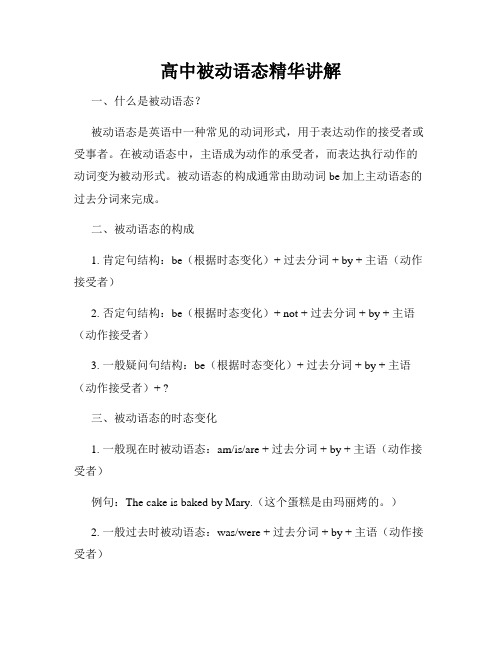
高中被动语态精华讲解一、什么是被动语态?被动语态是英语中一种常见的动词形式,用于表达动作的接受者或受事者。
在被动语态中,主语成为动作的承受者,而表达执行动作的动词变为被动形式。
被动语态的构成通常由助动词be加上主动语态的过去分词来完成。
二、被动语态的构成1. 肯定句结构:be(根据时态变化)+ 过去分词 + by + 主语(动作接受者)2. 否定句结构:be(根据时态变化)+ not + 过去分词 + by + 主语(动作接受者)3. 一般疑问句结构:be(根据时态变化)+ 过去分词 + by + 主语(动作接受者)+ ?三、被动语态的时态变化1. 一般现在时被动语态:am/is/are + 过去分词 + by + 主语(动作接受者)例句:The cake is baked by Mary.(这个蛋糕是由玛丽烤的。
)2. 一般过去时被动语态:was/were + 过去分词 + by + 主语(动作接受者)例句:The book was written by the famous author.(这本书是由这位著名作家写作的。
)3. 一般将来时被动语态:will be + 过去分词 + by + 主语(动作接受者)例句:The letter will be delivered by the postman.(这封信将会被邮递员送达。
)四、被动语态的用法1. 当我们不知道或不关心动作执行者时,使用被动语态。
例句:The car was stolen.(这辆车被盗了。
)2. 强调动作的承受者或受事者时,使用被动语态。
例句:The new stadium will be used for the Olympic Games.(新体育场将被用于奥运会。
)3. 在科学、新闻报道中常使用被动语态。
例句:A new vaccine has been developed by scientists.(科学家们研发出了一种新疫苗。
被动语态讲解
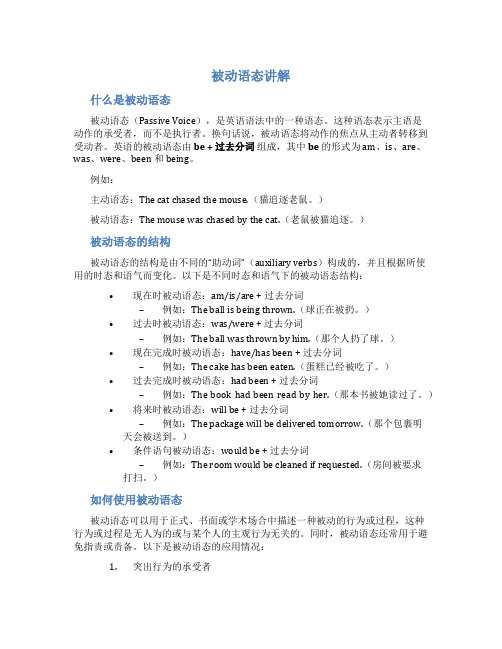
被动语态讲解什么是被动语态被动语态(Passive Voice),是英语语法中的一种语态。
这种语态表示主语是动作的承受者,而不是执行者。
换句话说,被动语态将动作的焦点从主动者转移到受动者。
英语的被动语态由be + 过去分词组成,其中be的形式为 am、is、are、was、were、been 和 being。
例如:主动语态:The cat chased the mouse.(猫追逐老鼠。
)被动语态:The mouse was chased by the cat.(老鼠被猫追逐。
)被动语态的结构被动语态的结构是由不同的“助动词”(auxiliary verbs)构成的,并且根据所使用的时态和语气而变化。
以下是不同时态和语气下的被动语态结构:•现在时被动语态:am/is/are + 过去分词–例如:The ball is being thrown.(球正在被扔。
)•过去时被动语态:was/were + 过去分词–例如:The ball was thrown by him.(那个人扔了球。
)•现在完成时被动语态:have/has been + 过去分词–例如:The cake has been eaten.(蛋糕已经被吃了。
)•过去完成时被动语态:had been + 过去分词–例如:The book had been read by her.(那本书被她读过了。
)•将来时被动语态:will be + 过去分词–例如:The package will be delivered tomorrow.(那个包裹明天会被送到。
)•条件语句被动语态:would be + 过去分词–例如:The room would be cleaned if requested.(房间被要求打扫。
)如何使用被动语态被动语态可以用于正式、书面或学术场合中描述一种被动的行为或过程,这种行为或过程是无人为的或与某个人的主观行为无关的。
被动语态讲解ppt

被动语态讲解
目录
• 被动语态的定义 • 被动语态的用法 • 被动语态与主动语态的转换 • 被动语态的特殊用法 • 常见错误分析
01
被动语态的定义
什么是被动语态
被动语态是一种动词形式,表示主语是动作的接 01 受者而不是执行者。
在被动语态中,主语是动作的承受者,而不是动 02 作的发起者。
被动语态强调动作对主语的影响,而不是主语的 03 行动。
被动语态的构成
01 被动语态由助动词be(am/is/are/was/were)+ 及物动词的过去分词构成。
02 不同时态的被动语态通过在be动词后面添加不同 的时态助动词(如do/does/did)和情态动词 (如can/could/may/might)来构成。
02 被动语态的否定形式是在be动词后面加not,例 如“The book is not written by him.”
VS
当动作的承受者是特定的人或组织时, 为了表示尊重或突出其重要性,也可 以使用被动语态。例如,“The president was greeted by the crowd.”(总统受到了人群的欢迎。) 这句话中,我们强调的是总统受到了 欢迎,而不是强调是谁在欢迎总统。
保持句子平衡,避免句式单调
被动语态
The movie was directed by the famous director.
- 1、下载文档前请自行甄别文档内容的完整性,平台不提供额外的编辑、内容补充、找答案等附加服务。
- 2、"仅部分预览"的文档,不可在线预览部分如存在完整性等问题,可反馈申请退款(可完整预览的文档不适用该条件!)。
- 3、如文档侵犯您的权益,请联系客服反馈,我们会尽快为您处理(人工客服工作时间:9:00-18:30)。
2.含有双宾语的主动句的转换
I gave the book to Mr. Smith yesterday. 昨天我给了史密斯先生一本书。
The book was given to Mr. Smith yesterday ( by me).
Hamlet was written by Shakespeare. 《哈姆雷特》是莎士比亚写的。
(一) 主动句与被动句的转换 1.含有单宾语的主动句的转换: People speak English almost all over the world. 世界各地都有人讲英语。 English is spoken almost all over the world.
被动语态
语态(voice)是个语法范畴,它是一种动词形式, 表示动词的主语与该动词所表示的动作之间的 主动和被动关系。当主语是动作的执行者时, 动词用主动语态(Active Voice);如果主语 是动作的承受者,动词便用被动语态(Passive Voice)。
We cleaned the classroom yesterday. 昨天我们打扫了教室。
口诀1:宾提前变主,主变介by宾,被动be加done,
时态看主动。
口诀2:如 遇双宾语,最好变间宾,如若变直宾,
间宾前加to / for (pass, lend, buy, write, bring, show, tell…)
பைடு நூலகம். He made me do the work. I was made to do the work by him.
语态转换
1. He teaches English in our school.
2. She gave me a book.
English is taught in our school by him.
I was given a book by her./A book was given to me by her.
H他T一一he被iis般般s认br现 过oe为og去在ka很时时rwd有::aeds才awwams气arisat/。tb/eisnrwi/lielnairare1ne9td6.do9o.nnee 这T现h本e在书b进r是o行k1e时9n6:b9i年kaem写is/成bise的i/n。agrreepbaeirinedg ndoown.e 那过辆去坏进了行时的:自行wa车s正/ w在e被re修b理ein。g done H现e在to完ld成u时s t:hehcaavtew/ahs abseinbgeewnasdhoendewhen we t/ oc他Th过一当T钢 H这aahbhl告e去般句lv笔 家eeeesed完 将 中w诉ap已工dtioeh成 含来od我onr经厂inm…kt时 有时h们eh用已.bwae: 情:打sei了经fl态ablhsd电ceb几 开h动aoteeaod话nn词年 张rlfelbyiu时时n。 。/eshiewse,他adhndi句el正flddbo子breo在ineen结sne给etdv构hooe猫rp为rneeae洗enlchey;澡adoebnua.。err他/ssgm..说o工这uins支gt
The classroom was cleaned by us yesterday. 昨天教室被我们打扫了。
动词的被动语态由“助动词be+及物动 词的过去分词”构成。当主动句变为被 动句时,原来的宾语变成了主语,原来 的主语变成了介词by 的宾语。主动句与 被动句的结构虽然不同,但动作的执行 者和承受者的关系并没有改变。
口诀3:这些动词真奇怪,主动句中to 离开,被动 句中to回来.(feel, listen to, hear, let have, make, look at, see, watch…)
4.They take good care of the baby.
The baby is taken good care of by them.
Mr. Smith was given a book yesterday (by me).
3. 含有介词动词的主动句的转换 They have never listened to him. 人家从不听他的话。 He has never been listened to.
表示被动意义的主动句: Cotton feels soft. 棉花摸上去很柔软。 Ripe apples pick easily. 熟了的苹果容易摘下来。
注意:含动词词组的被动语态,须将其看作一个 整体,不可把它们分隔开来。
有些情况下动词的主动形式也可以表示被动意义。
一、表示“开始”;“结束”类的动词。常见 的这类动词有begin, start, open, close, end, finish, stop等。例如:
School begins in September. The stores in this area open later at weekends than at weekdays.
当主动句的宾语是that引导的宾语从句, 可转换为两种形式的被动句。
1) 用先行的it作形式主语,把宾语从句变成后置的 主语从句; 2) 把宾语从句里的主语变成被动句的主语,同时把宾 语从句中的谓语变成不定式短语。
People believe that he is an honest boy. 大家认为他是个诚实的孩子。
作将于三小时后完成。 The baby must be looked after well. 这孩子必须被好好照顾。
在被动句中有时用by- 词组,有时不用。一般 来说,当动作的执行者为谁不甚清楚,不甚重要 或难以说出时,通常不用by。但有时为了强调 动作执行者或者由于上下和结构上的需要则必须 使用 by 词组。例如:
